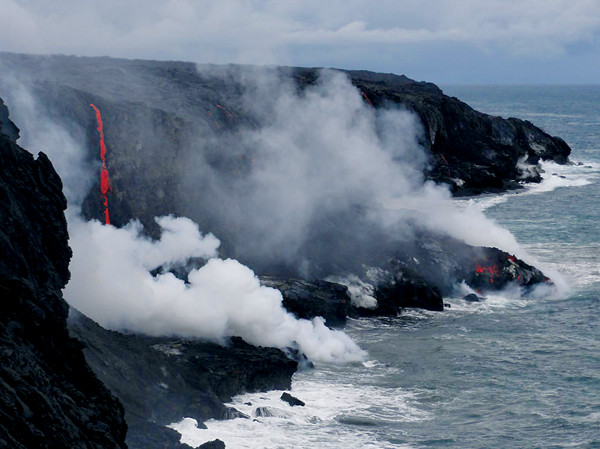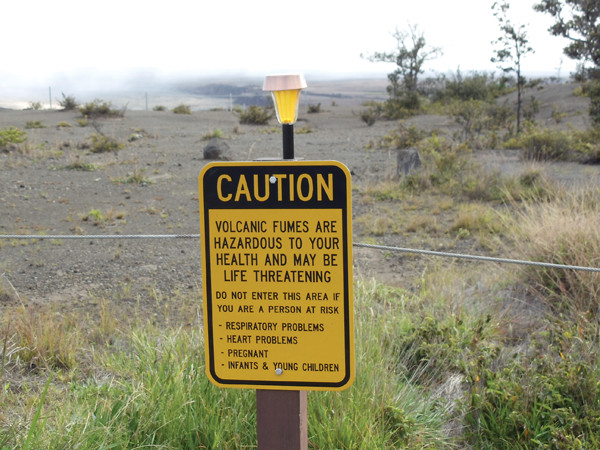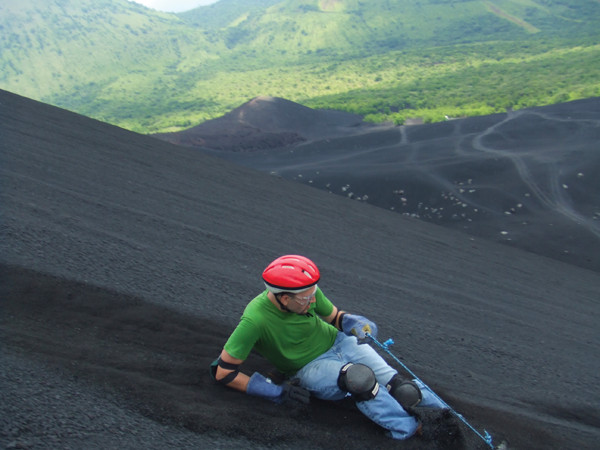
by Sara E. Pratt Friday, March 16, 2012

Hawaii's Kilauea volcano often flows into the ocean, creating a beautiful but dangerous site. USGS HVO

Warning sign outside the visitor's center at Hawaii Volcanoes National Park. Megan Sever

Sandboarding is a popular tourist activity on Cerro Negro in Nicaragua. NicaPlease
In November 2000, rangers at Hawaii Volcanoes National Park made a gruesome discovery. The bodies of a man and a woman, in an advanced state of decomposition, were found near the site where lava from the Kilauea eruption flows into the sea, sending up plumes of scalding white steam. The area, aptly named the Eruption Site, is littered with chunks of tephra, a glassy volcanic rock, which are formed and ejected violently into the air when the 2,000-degree-Celsius lava is quenched by seawater.
The two bodies were 100 meters inland from the Eruption Site and they displayed no visible signs of trauma, so rangers knew that the victims had not been hit and killed by flying tephra. “That one was a bit of a mystery,” says Travis Heggie, an eruption duty ranger at the time, who was part of the team tasked with recovering the bodies and investigating the incident. The bodies were placed in slings and airlifted off the lava bench by helicopter. An autopsy report two days later revealed the cause of death: pulmonary edema, or swelling of the lungs, due to the inhalation of hydrochloric acid. The autopsy also noted that the advanced decomposition occurred where skin was exposed to the air, or covered by only a single layer of clothing. The tissue had been decomposed, not by natural postmortem decay, but by acid rain.
Lava itself releases toxic gases, including carbon dioxide, sulfur dioxide, hydrogen sulfide and hydrofluoric acid. When lava interacts with seawater a variety of other toxic gases are produced, including hydrochloric acid, which is highly corrosive. The lava haze, or laze, as it is called, can be deceptively deadly.
“It looks like a pretty white steam cloud, but it’s not. It’s acid,” Heggie says, adding that the accident was all the more tragic because the woman worked at the park and likely knew about the risks of the plume, which can quickly change course with the winds.
Between 1992 and 2002, there were 40 fatalities, 45 serious injuries and 53 minor injuries reported within Hawaii Volcanoes National Park. Each year, tourists are injured, not just by volcanic laze, but by a variety of hazards — some mundane and predictable, others bizarre and unexpected. Overall, incidents in Hawaii have decreased since 2002, Heggie says, when stricter safety guidelines were implemented and tourist safety education efforts were ramped up.
However, the hazards facing tourists at volcanoes are not unique to Hawaii. Globally, tourist injuries and deaths at volcanoes are on the increase, driven by the rise in popularity of volcano geotourism.
“When we look at the tourist numbers, we are talking about mass tourism in potentially dangerous areas,” says Patricia Erfurt-Cooper, a lecturer in tourism planning at Ritsumeikan Asia Pacific University in Japan, and lead author of the 2010 book “Volcano and Geothermal Tourism.”
More than 100 million people visit volcanic sites around the world every year. In the United States, Hawaii Volcanoes National Park, where Kilauea has been erupting almost continuously since 1983, attracts 2 million visitors; the geothermal features at Yellowstone National Park attract roughly 3 million visitors a year. More than 1 million people visit dormant Mount Rainier in Washington, which is one of 16 “Decade Volcanoes” identified by volcanologists as part of the UN International Decade for Natural Disaster Reduction as being worthy of study due to their histories of large, destructive eruptions and their proximity to large population centers.
Decade Volcanoes also happen to be some of the most popular tourist destinations, Erfurt-Cooper says, part of the trend of volcano tourism, a subtype of geotourism, which is an offshoot of the ecotourism that has become popular over the last few decades. Many governments are promoting volcano tourism to bring in money, and many volcanoes are being designated as World Heritage Sites and Geoparks, which makes them more attractive destinations for tourists, says Erfurt-Cooper, whose next book, “Volcanic Tourist Destinations: Geoparks of the World,” is due to be published this year.
In addition, there is also a growing trend toward adventure tourism, in which people are pushing the envelope further and further, she says. Climbing an active volcano is just one such extreme attraction that appeals to millions of people every year. That is due, in part, to a rise in reality adventure- and travel-based TV shows focused on exotic locales, including volcanoes.
“To view an active volcano erupting is a once-in-a-lifetime experience for most people,” says Tobias Schorr, a photographer and tour guide with Volcano Discovery based in Troisdorf, Germany. The company, founded by volcanologist Tom Pfeiffer, leads adventure and educational travel tours, including tours to active volcanoes in Italy, Greece, Iceland, Hawaii, Indonesia, Vanuatu and Guatemala.
The level of risk posed by any individual volcano varies widely based on a number of factors, including the type of volcano, whether it is active or dormant, the weather conditions, and the physical condition of the tourist.
“Any mountain can pose a danger to inexperienced tourists,” Erfurt-Cooper says. Because volcano tourism usually involves travel to remote mountain destinations and activities like skiing, hiking and mountain climbing, many of the accidents and injuries sustained on volcanoes — from mild cuts and abrasions to broken bones to life-threatening conditions like hypothermia and altitude sickness — occur on dormant volcanoes.
At active volcanoes, the risks are compounded.
Among active volcanoes, Kilauea is probably the safest for two reasons: it is an effusive-type eruption, and the National Park Service provides tourists with enough information on “how to stay safe in an unsafe environment,” Erfurt-Cooper says. “Hawaiian eruptions, for example, have lava gently oozing out in certain areas and this can be watched from close up,” she says, “preferably under supervision of park rangers or trained tour guides. Yet people still are injured and some die there.” Flying rocks, killer gas clouds and scalding hot ocean waves are not on the minds of most vacationers who want to relax and enjoy the beautiful scenery. This leads to a lackadaisical attitude about safety that is not only a barrier that park rangers and tour guides must overcome in order to educate tourists about safety risks, Heggie says, but also a serious risk factor in itself.
In 2004, Heggie published the first comprehensive study of the health and safety issues facing lava hikers in Hawaii. “A lot of the injuries we saw were hiking-related,” he says. “Silica will just cut you to shreds.” But the study also showed just how unprepared tourists can be. In a survey of more than 800 hikers leaving the lava fields, he found that many had pre-existing health issues, including heart problems and asthma, which can be exacerbated by gaseous fumes and particulates emanating from lava vents. He also found that more than half were novice hikers, unprepared for the rigors of an up-to-10-kilometer hike across the lava fields. Most of the hikers were ill-prepared, lacking flashlights, sufficient water, first-aid kits and sunscreen. Seven percent were wearing dress shoes or high heels. Five percent admitted they were intoxicated. In addition, 93 percent admitted hiking beyond the warning signs posted 500 meters from the Eruption Site where lava enters the ocean.
The concerns are obvious. Tourists unprepared for a basic hike would be even more ill-equipped to face volcanic and geothermal risks such as unexpected eruptions, toxic gas emissions or scalding water.
The most apparent hazard at an active volcano is exposure to lava, which can reach 2,000 degrees Celsius. Yet tourists are often intent on getting as close to it as they can. “I think it’s the fascination of seeing creation and destruction at the same time,” says Heggie, who is now a professor of Sport Management, Recreation & Tourism at Bowling Green State University in Bowling Green, Ohio.
The cooler products of lava also cause many injuries — for example, when tourists venture out onto the surface of thin, unsupported lava benches or tubes. In April 1993, two tourists died at Kilauea’s Eruption Site when a lava bench — which looked solid from above but was unstable below — collapsed.
Heggie recalls one incident in which a woman walking over a lava tube broke through the thin crust and fell nine meters to the floor of the tube breaking both of her legs. That incident happened during one of the park’s rare closures and the woman had entered the park illegally, Heggie says, via a backcountry trail with a local she had paid to get her into the park. “Even when we tell people they can’t go out there, they go out and do it anyway,” he says.
In addition to the hazards of the volcanic landscape are the unseen perils of the volcanic atmosphere. Volcanic gases are hot, toxic and often undetectable, and large volumes can be emitted and carried by winds to areas that may have had breathable air just moments before. Gases can also be trapped in underground pockets or lava tubes, and emitted suddenly when a lava bench collapses or a skylight opens.
“An often forgotten danger is volcanic gas in fumaroles,” Schorr says. There have been casualties in Italy and in Greece, where two people were killed by gas at the Pausanias baths in Methana, a volcanic peninsula about 50 kilometers southeast of Athens.
At Mammoth Ski Area in California, three ski guides were killed in 2006 as they were fencing off a known fumarole, which had been covered by a deep snowfall, in order to prevent skiers from falling into it. The first victim broke through the snow and fell seven meters into the fumarole, and the second and third victims attempted to save him. All three were asphyxiated. Readings taken by the fire department a few hours after the accident showed the carbon dioxide level inside the fumarole was more than 100,000 parts per million (ppm) with a carbon monoxide concentration above 40,000 ppm.
Accurate statistics on fatalities and injuries due to volcano geotourism worldwide are hard to come by. No international organization tracks such incidents, and each country handles tourism safety differently.
When a vent a few kilometers from Eyjafjallajökull started erupting in Iceland a month before the main volcano blew in April 2010, tourists flocked to see the show, enjoying helicopter tours and catered dinners. Heggie, who was also the Public Risk Management Specialist and Tort Claims Officer for the National Park Service until 2006, says that in countries like Iceland where there is no tort culture, tourists are largely responsible for their own safety.
Schorr says that of all the countries in which he guides, “only Hawaii in the U.S. is strict about guidelines.” The U.S. national parks generally have the best safety strategies for visitors, Erfurt-Cooper agrees, “although not necessarily in enough languages to get the message across.” However, she adds, “many people don’t listen to advice and will attempt to explore active volcanic environments on their own, which is asking for trouble.”
Heggie credits the more extensive safety guidelines in the U.S. to both a tort culture and the flawed assumption that the national parks are inherently safe, which leads many tourists to flaunt the safety guidelines. “The attitude in the U.S. is: ‘This is a national park; our government wouldn’t let us do anything that wasn’t safe,’” he says.
In Japan, warning signs and safety information at active volcanoes such as Mount Unzen and Mount Aso are usually provided in four languages (English, Korean, Chinese and Japanese), which covers the majority of people visiting Japanese volcanoes, Erfurt-Cooper says. But even Mount Aso has claimed a few victims who suffered respiratory problems due to the toxic fumes from the crater.
“There is a lot of room for improvement regarding safety information for international tourists elsewhere,” Erfurt-Cooper says. In developing nations, many governments are reluctant to establish guidelines or to publicize safety issues or incidents for fear of diminishing the flow of tourist dollars, Heggie notes, and tour guides are largely unregulated or monitored for safety.
In Central America, dozens of people die on volcanoes each year. Between 2007 and 2011, 29 tourists died on Arenal in Costa Rica, mainly from exposure to volcanic gases but also due to falls from the crater rim and even heart failure. In Nicaragua, at least 72 tourists have died on the slopes of Cerro Negro over the last five years. Although it hasn’t erupted since 1999, the volcano has recently become a popular destination for sandboarding — riding a wooden board, either standing surfboard-style or seated toboggan-style, at speeds close to 90 kilometers per hour down the steep, coarse-sand slopes.
In Africa last November, when Mount Nyamulagira in the Democratic Republic of Congo began erupting, officials at Virunga National Park invited tourists to go on overnight treks to see 300-meter-tall lava fountains and glowing flows on the north flank. Virunga is a World Heritage Site containing two active volcanoes: Nyamulagira and Mount Nyiragongo, which last erupted in 2002. (A travel feature on a trek to the summit of Mount Nyiragongo, which was not erupting at the time, was featured in EARTH’s February issue.)
There currently are no international safety guidelines for volcano tourists. Challenges to implementing them include the wide range of volcano types, local environments and language barriers.
But some people are working to change that. For the first time, a session on volcano tourism was convened at the 6th International Cities on Volcanoes conference held in Tenerife, Spain, in 2010. Erfurt-Cooper moderated the session, which addressed safety concerns and practices and risk management.
Schorr warns that the burgeoning popularity of volcano geotourism may prove dangerous to itself, as small, educational tours led by experienced guides familiar with volcanology give way to large bus tours that disgorge hundreds of tourists at volcanic destinations that are treated as mere sightseeing stops. “Mass tourism is the biggest danger at volcanoes anywhere on the planet,” Schorr says. “We can handle a group up to 20 persons, but not hundreds of tourists.”
If people are going to go out exploring volcanoes, they need to choose knowledgeable guides who have previous experience with a particular volcano and who respect the possible dangers, Schorr says. “The most casualties take place on nonguided tours,” he says. Volcano Discovery uses safety equipment, including good footwear, gas masks and helmets, but the most important safety precaution the guides employ, he says, is first conducting “a strict study of local seismic stations in cooperation with local scientists.”
Second, people need to be aware of the hazards, especially when visiting volcanoes that can form lava domes and erupt catastrophically, such as Mount Merapi in Indonesia, Soufrière Hills in Montserrat, and Mount Rainier and Mount Shasta in the Cascades. “All volcanoes that can erupt violently are dangerous, especially where tourists may not have any prior warning,” Erfurt-Cooper says.
However, volcanoes can be monitored and the risk of an eruption can be assessed by geoscientists — so for the most part, tourists can be kept away. What worries Schorr are the other less predictable hazards of adventure travel.
“The highest risks are terrorist attacks, like in Ethiopia, Congo or Guatemala; unsafe airports, like in Africa or Indonesia; or traffic and diseases,” Schorr says. “The volcanoes themselves are not the biggest danger.
© 2008-2021. All rights reserved. Any copying, redistribution or retransmission of any of the contents of this service without the expressed written permission of the American Geosciences Institute is expressly prohibited. Click here for all copyright requests.